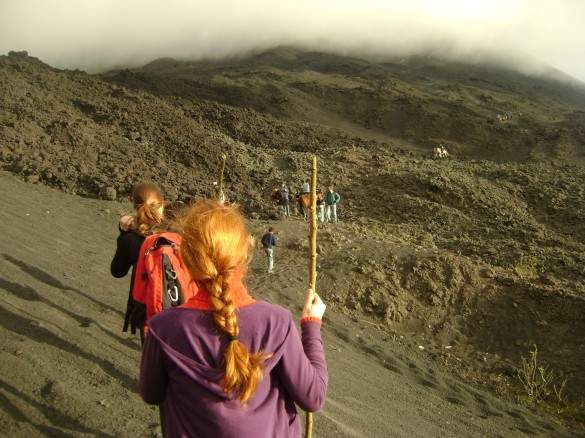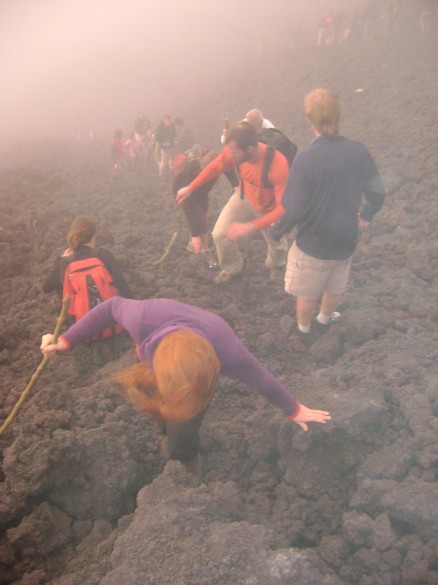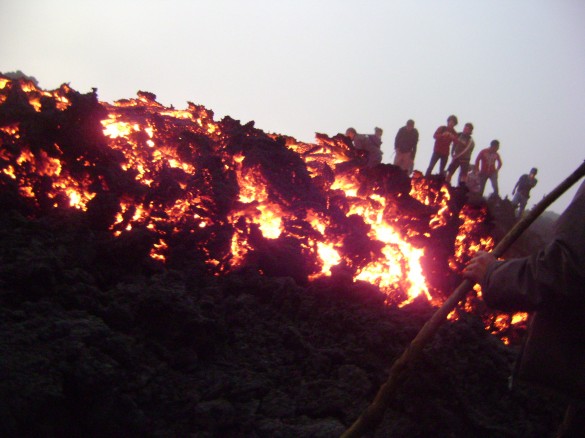“Okay, who brought the One Ring?” I asked, slightly out of breath.
The worn-out hikers around me only chuckled in response, but at least my Lord of the Rings reference didn’t go to waste. I took another step up, and my boot slid in the scree, sending a shower of pumice onto those climbing below. We weren’t on Mount Doom, but I’m pretty sure we were on its stunt double: Pacaya
Pacaya was a volcano.
One that was currently erupting.

As one of Guatemala’s most active and accessible volcanoes, Pacaya is very popular. Tourists from all over the world attempt to climb to the top and look into its burbling mouth, high above and far away from the lava churning below.
Diana and I were two of those tourists, except that we ended up closer to the lava than most.
After two bumpy hours, the mini-van that we were packed into slowed and then stopped. Children appeared outside, brandishing long sticks and yelling and slapping at the windows. I had a brief moment of panic, fearing that we had stumbled onto some blood-thirsty Lord-of-the-Flies style tribe. Instead, it turned out to be kids trying to sell us hiking staffs. One of our fellow riders bought one for $3 before we followed Jose, our assigned guide, up a steep dirt path.
For the next hour we walked up through the woods, panting along switchbacks and trying to get a glimpse of the future through the dense foliage. Although our group of eight was mostly alone for the first hour, as soon as we broke the tree line we could see hundreds of people hiking almost single-file up the volcano, their windbreakers creating a tapestry of multi-colored threads on Pacaya’s black cloth.

The polarization was striking. The woods we had been in were verdant: thick, lush and Technicolor green. In contrast, what went before us was a waste: barren, lifeless, black on a blacker black. Here, we could see straight to the top of Pacaya’s near perfect cone, could appreciate its full measure. The measure as of late was 7,650 feet, but that was only approximate since Pacaya was fond of growing itself taller by slowly painting its way up with the innards of the earth before blasting a few feet off itself whenever it has the whim.
We’d been given two choices before leaving Antigua: a morning hike or a sunset hike. We thought the sunset hike would be more beautiful, the night hike back more exhilarating, but as our mini-van had been an hour late in picking us up, the sun had already brushed its teeth and was heading to bed before we’d even left the trees.
We began walking up in the dimming light, the forest’s packed earth giving way to loose pumice and ash, the remains of continuous eruptions going back to 1961. Above us, earlier climbers were gleefully volcano surfing down, sliding in bounding steps, waves of scree sliding before them. We hiked away from them, trying to keep to a rocky path glazed shiny by former lava streams.
The higher we got, the harder it got, and I felt more and more like I was in a fantasy movie, climbing towards its climax. Hard winds blew, pummeling us with ash and grit. We all had our hoods up to protect our faces, tunneling our vision and muting reality. Sulfur strongly scented in the air as clouds of vapor shifted us into fog and then clear, fog and then clear. The ground was sliding constantly underfoot, those above showering us with pebbles of pumice before we did the same to those below. I hadn’t brought gloves, a bit of a mistake as the path became progressively steeper, forcing me to grab onto sharp, jagged rocks to haul myself upwards. What seemed really cool when I was looking at pictures in Antigua was now starting to really suck. Climbing a volcano isn’t an adventure. It’s: Climbing. A. Volcano.
As the light continued to fade, I tenderly tested my footing and took another step up.
After an hour and a half of climbing, a process of going two feet up only to slide one down, we finally began to reach the top. The sun was almost completely below the horizon, and I started to notice that something was glowing up ahead. I was confused. Wasn’t the top of the volcano still several hundred feet away? Didn’t I have to climb over the lip before I could see the magma below?
As I got closer, I saw that those ahead of me had stopped and were looking at something.
They were looking at magma boiling over the lip and streaming towards us..
My brain does not process danger like most. I should have been thinking: Run! What I was thinking was: Amazing.
The volcano was slowly erupting. I had heard that this happened on occasion, had even seen pictures of people standing beside flowing lava with grins on their faces. I had seen those pictures and thought: I want that to be me.
I had gotten my wish.

The lava was a glowing yellow and orange ribbon undulating ever so slowly towards us. It was unbelievably thick despite being a liquid, inching forward so snail-like that it gave me the feeling of safety and control. Its surface was crusty in places, cooled by the air into black rock that slid down and crashed in sparks against the ground.
The sun had gone down, and now this glowing lava was our only source of light. I hiked past its end and along it, entranced. The heat was absolutely intense, that feeling you get when you open an oven to see how the food is cooking, only to get slapped in the face by 400 degrees. This was that, only now I couldn’t shut the oven. I looked and looked and looked, the wafting vapor stinging my eyes, but me not wanting to do anything but stare at the shifting colors.
This was nature primal. This was the blood of creation. This was the center of the earth.
I took pictures of it. I had people take pictures of me beside it. Diana and I kissed in front of it. I even took a hiking stick and poked it, the end of the stick bursting into flames.
And then I noticed that it was starting to speed up.
People began yelling. The path we’d hiked up, that path of glazed rock? It had been made by the last lava flow. Which meant it was the path that this lava was going to take.
Our path.
Our way down.
I hurried back along the river of lava, saw it now covered a place I’d been walking on not ten minutes before. And it was then I realized that I had been idiotically taking pictures while a volcano was erupting.
People were moving quickly now, half-running, half-sliding down the sheer path. I put on my headlamp and hurried after them, Diana’s hand in mine, past people who were just now able to see the what was causing the glow.
“The volcano is erupting,” we told them.
“Cool,” they said back.
I volcano surfed down, something that would have been far more enjoyable were it not pitch black, and were I not worried about spontaneously combusting. How would that work? Would I catch flame like the stick? Would I instantly char? Would my flesh immediately melt into the magma?
I tried not to think about it as my feet sunk into calf-deep ash, the black grit filling my boots as I kicked up a dirty stream of dust below me, hands outstretched for balance and feeling exhilarated despite myself. What took 90 minutes to climb took less than fifteen minutes to slide down.
As we neared the tree line, I took a moment to look back.
Pacaya was a black silhouette against the purple night sky, an orange-red haze crowning its top and a thin, glowing yellow line marking the lava. Scattered down it were moving dots of white: headlamps and flashlights. Then, as I was watching the lights jig and dance, I saw Pacaya spurt. Red and yellow streams flashed twenty feet into the sky and the lava shifted directions, flowing into a new channel blown open by the explosion and arcing into the air like a molten waterfall.
It flowed away from the hikers, and I felt like I had just witnessed a miracle.
I thanked God, and walked into the woods.
The next day, Diana and I were chatting about our close call when an American woman overheard us told us the news: hikers had been caught in the spurt that I had seen, had been hit and burned by chunks of flaming rock. “The had to bring them off on the backs of donkeys,” she said.
Luckily, no one had died.
I digested that information, wondered why we as a species felt the need to put ourselves in harm’s way for photos and mementos and meaningless entertainment.
I decided to stop thinking about it and went about my day.